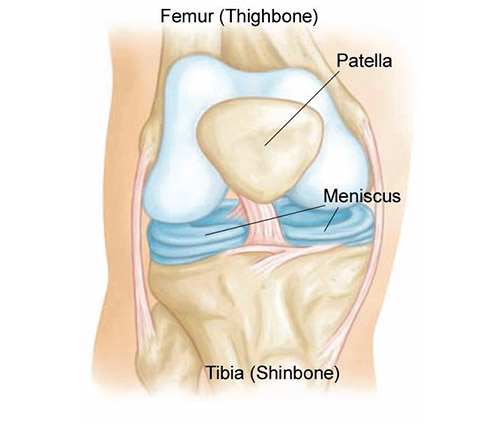
There aren’t too many adults out there who get to age 40 (often younger in athletes) without having experienced a significant episode of knee pain at one time or another. For most of us these occurrences are self-limited; yet for some the discomfort continues and becomes a lingering issue resulting in dysfunction for months at a time. This is when I see these folks in the office and have the opportunity of identifying the problem as a tear in their meniscus.
The menisci are interesting. These C-shaped structures act as shock absorbers on each side of a knee joint. Having two in each knee, they function to effectively soften the impact as our thigh bones come crashing down against the joint surface of our leg bones with every step. Imagine for a moment a heavy cue ball resting on a table. When looking at it from the level of the table, it would appear that the ball’s spherical nature results in only a small point of contact between it and the flat table. Now imagine a doughnut on this table, with the cue ball resting in its center, and you will appreciate the essential function of the two menisci in helping the two round femoral condyles in each knee distribute the strong forces of body weight.
Meniscal tears can occur for many reasons, with some resulting from quick twisting movements while others when the knee forcibly bends. They usually present with pain on the sides or back of the knee and can be associated with acute swelling. Additionally, tears can develop insidiously over time due to excessive stress within the knee compounded by age. Age is a big factor, since as we get older the limited potential for healing tears in a meniscus greatly diminishes. Based on their orientation, even seemingly small tears can quickly render a meniscus less able to protect our knees, and specifically the underlying cartilage that cushions the joint. Imagine again the above scenario of the doughnut, but this time with a small thin bite taken out of it. You can predict how the doughnut fails to provide the expected support as the femoral condyle now engages the middle of it. It’s when the meniscus no longer provides its supporting function that arthritis, i.e. wearing and thinning of the underlying protective cartilage layer, can progress over time.
The focus of addressing meniscus tears centers around identifying whether the tear is a source of pain and then secondarily the type of tear it is. The patient’s description of pain and my physical exam help me figure out the former, and the results of a knee MRI can provide the answer to the latter. Ideally if a tear is persistently painful despite conservative treatment like physical therapy, then surgery is considered to either repair the meniscus or to simply smooth out the tear so it no longer gets caught in the knee with movement causing pain. Since joint preservation is a focus of my practice, I aim to repair meniscal tears whenever it’s possible and appropriate.
Over time and even without surgery, pain caused by a meniscal tear can improve. Often the tear no longer catches in the knee with movement and is considered to have stabilized. These tears can be watched for worsening symptoms and can be surgically treated if symptomatic in the future. This approach applies to most of the meniscal tears I see in practice, especially in those in people over age 50. Other types of tears, such as radially oriented tears and tears of the root attachments of the meniscus, should be surgically addressed since these injuries can render the meniscus nonfunctional allowing arthritis to progress relatively quickly. Ultimately the two menisci in each knee can be sources of pain, but a thorough evaluation by an experienced surgeon can help patients chart their course toward recovery.
At The Center for Musculoskeletal Disorders in Englewood, New Jersey, we attempt to individualize your knee and overall joint issues. All knees are not the same! If you feel we can help please make an appointment at 2015103777.
By Dr. Donald Heitman
Donald Heitman, MD, FAAOS is an orthopedic surgeon at The Center For Musculoskeletal Disorders/Englewood. His specialty is sports medicine.












